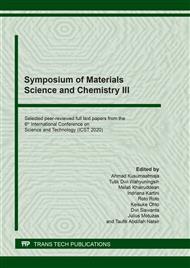[1]
P-C. Aïtcin. Retarders. In: P-C Aïtcin, R.J. Flatt, editors. Science and Technology of Concrete Admixtures. Elsevier, 2016, pp.395-404.
DOI: 10.1016/b978-0-08-100693-1.00018-7
Google Scholar
[2]
C. Ishee and S. Surana. Hot weather concreting. In: Mindess, S., editor, Developments in the Formulation and Reinforcement of Concrete, Elsevier, 2019, pp.131-150.
DOI: 10.1016/b978-0-08-102616-8.00006-x
Google Scholar
[3]
A.Schackow, C. Effting, I.R. Gomes, I.Z., Patruni, F. Vicenzi and F. Kramel. Temperature variation in concrete samples due to cement hydration. Applied Thermal Engineering 103 (2016), 1362–1369.
DOI: 10.1016/j.applthermaleng.2016.05.048
Google Scholar
[4]
I. Chu, J.K. Kim, Y. Lee, M.N. Amin and B.S. Jang. Application of a thermal stress device for the prediction of stresses due to hydration heat in mass concrete structure, Constr. Build. Mater. 45 (2013), 192–198.
DOI: 10.1016/j.conbuildmat.2013.03.056
Google Scholar
[5]
X. Zou, A. Chao, Y. Tian, N. Wu, H. Zhang, T.Y. Yu and X. Wang. An experimental study on the concrete hydration process using Fabry–Perot fiber optic temperature sensors, Measurement 45 (2012), 1077–1082.
DOI: 10.1016/j.measurement.2012.01.034
Google Scholar
[6]
American Society for Testing and Material (ASTM). Standard specification for chemical admixtures for concrete: C494/C494M-05. ASTM International, West Conshohocken, PA, (2005).
Google Scholar
[7]
B.J. Smith, L.R. Roberts, G.P. Funkhouser, V. Gupta and B.F. Chmelka. 2012. Reactions and surface interactions of saccharides in cement slurries. Langmuir 28 (40), 14202-14217.
DOI: 10.1021/la3015157
Google Scholar
[8]
D. Marchon and R.J. Flatt. Impact of chemical admixtures on cement hydration. In: Aïtcin, P.-C., Flatt, R.J., editors. Science and Technology of Concrete Admixtures. Elsevier, 2016, pp.279-304.
DOI: 10.1016/b978-0-08-100693-1.00012-6
Google Scholar
[9]
D. Marchon, S. Mantellato, A.B. Eberhardt and R.J. Flatt. Adsorption of chemical admixtures. In: Aïtcin, P.-C., Flatt, R.J. editors. Science and Technology of Concrete Admixtures. Elsevier, 2016, pp.219-256.
DOI: 10.1016/b978-0-08-100693-1.00010-2
Google Scholar
[10]
V.K. Peterson and M.C.G. Juenger. Time-resolved quasielastic neutron scattering study of the hydration of tricalcium silicate: effects of CaCl2 and sucrose, Physica B: Condensed Matter, 2006, 385–386, 222–224.
DOI: 10.1016/j.physb.2006.05.194
Google Scholar
[11]
V.K. Peterson and M.C.G. Juenger. Hydration of tricalcium silicate: effects of CaCl2 and sucrose on reaction kinetics and product formation, Chem. Mater. 18 (2006), 5798–5804.
DOI: 10.1021/cm061724y
Google Scholar
[12]
American Society for Testing and Material (ASTM). Standard test method for sieve analysis of fine and coarse aggregates: C136/ C136M-19, ASTM International, West Conshohocken, PA, (2019).
Google Scholar
[13]
American Society for Testing and Material (ASTM). Standard specification for concrete aggregates: C33 / C33M-16e1, ASTM International, West Conshohocken, PA, (2016).
Google Scholar
[14]
Sika Indonesia. Product data sheet Plastocrete® RT6 Plus. Cileungsi, Bogor, Indonesia, (2016).
Google Scholar
[15]
American Concrete Institute (ACI) Committee 318. Building Code Requirements for Structural Plain Concrete and Commentary: ACI 318.1R-89 (revised 1992), American Concrete Institute, Detroit, MI, (1992).
DOI: 10.14359/2769
Google Scholar
[16]
American Concrete Institute (ACI) Committee 211. Standard Practice for Selecting Proportions for Normal, Heavyweight, and Mass Concrete: ACI 211.1-91 (reapproved 2002), American Concrete Institute, Farmington Hills, MI, (2002).
DOI: 10.14359/10987
Google Scholar
[17]
American Society for Testing and Material (ASTM). Standard test method for time of setting of concrete mixtures by penetration resistance: ASTM C403 / C403M-16, ASTM International, West Conshohocken, PA, (2016).
Google Scholar
[18]
American Society for Testing and Material (ASTM). Standard test method for compressive strength of cylindrical concrete specimens: C39-86, ASTM International, West Conshohocken, PA, (2002).
Google Scholar
[19]
Y. Xu, X. Zhang, B. Ma and X. Liao. Effects of Temperature on the Performance of Sucrose in Cement Hydration. Journal of Materials in Civil Engineering 23 (2011), 1124-1127.
DOI: 10.1061/(asce)mt.1943-5533.0000264
Google Scholar
[20]
S. Ahmad, A. Lawan, M. Al-Osta. Effect of sugar dosage on setting time, microstructure and strength of Type I and Type V Portland cements. Case Studies in Construction Materials 13 (2020), e00364.
DOI: 10.1016/j.cscm.2020.e00364
Google Scholar
[21]
D. Marchon and R.J. Flaat. Impact of chemical admixtures on cement hydration. In: P-C Aïtcin, R.J. Flatt, editors. Science and Technology of Concrete Admixtures. Elsevier, 2016, pp.279-304.
DOI: 10.1016/b978-0-08-100693-1.00012-6
Google Scholar
[22]
M. Bishop and A.R. Barron. Cement hydration inhibition with Sucrose, Tartaric Acid, and Lignosulfonate: Analytical and Spectroscopic Study. Ind. Eng. Chem. Res. 2006 45 (2016), 7042-7049.
DOI: 10.1021/ie060806t
Google Scholar
[23]
H.S. Arel. The effect of lignosulfonates on concretes produced with cements of variable fineness and calcium aluminate content. Constr. Build. Mater. 131 (2017), 347-360.
DOI: 10.1016/j.conbuildmat.2016.11.089
Google Scholar
[24]
M. Pérez-Nicolás, A. Duran, I. Navarro-Blasco, J.M. Fernández, R. Sirera, J.J. Alvarez. Study on the effectiveness of PNS and LS superplasticizers in air limebased mortars, Cem. Concr. Res. 82 (2016), 11–22.
DOI: 10.1016/j.cemconres.2015.12.006
Google Scholar
[25]
I.B. Topçu and O. Atesin. Effect of high dosage lignosulphonate and naphthalene sulphonate based plasticizer usage on micro concrete properties, Constr. Build. Mater. 120 (2016), 189-197.
DOI: 10.1016/j.conbuildmat.2016.05.112
Google Scholar


